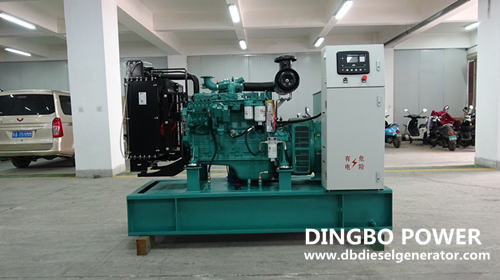The cooling and ventilation of diesel generator set is very important. The machine room shall have sufficient air flow to meet the needs of genset combustion, cooling and ventilation.
1.Cooling requirements
1. When installing diesel generator set, make the radiator close to the exhaust outlet as far as possible to prevent the recirculation of hot air. When there is no air duct, it is recommended that the distance between the radiator and the exhaust outlet should not exceed 150mm. If the machine room is difficult to meet the above requirements, it is recommended to install corresponding air ducts.
2. The area of the air outlet shall be 1.5 times that of the radiator. Generally, the air duct and exhaust louver shall be installed in conjunction with the radiator.

3. The bending of the air duct shall pass through the appropriate elbow. If the pipeline is too long, the size shall be increased to reduce the exhaust back pressure. Long distance air duct silencer shall be specially designed according to the characteristics of the building.
4. The air inlets and outlets of buildings are usually equipped with louvers and grids. When calculating the size of air inlets, the effective ventilation area of louvers and grids shall be considered.
5. A large amount of air is required for genset combustion and cooling, which is often ignored. It is recommended that the total area of air inlet shall be at least twice the heat dissipation area of the diesel generator. All air vents shall be able to prevent rainwater from entering. In cold climate areas, the machine room of standby and rarely operating generator sets shall be able to be insulated. Adjustable louvers can be installed at the air inlet and exhaust outlets. The louvers can be closed when the genset is not running. For diesel generators that are put into operation automatically due to main power failure, it is usually necessary to install standard thermostatically controlled immersion cooling water heaters.
2.Ventilation requirements
1. The damper or shutter can isolate the machine room from the surrounding environment, and its opening and closing operation shall be controlled by the operation state of the unit.
2. The movable damper installed in the machine room in cold areas shall allow the recirculation of air flow in the machine room to heat the machine room when the machine is cold, so as to improve the efficiency of diesel generators.
Hope above information is helpful to you when you start to design the diesel generator room. More technical information support and generator set price, welcome to contact us by email dingbo@dieselgeneratortech.com.
The good environment of the diesel generator room plays a very important role in the normal operation of the diesel generator. Therefore, we should pay great attention to the cooling and ventilation measures of the room, so as to ensure the reliability of the power supply of diesel generator.
Treatment of cooling water for diesel generator set
The cooling system of diesel genset is vulnerable to corrosion and pitting corrosion. In order to reduce the degree of corrosion, anti rust agent should be added to the cooling water. However, it should be noted when adding.The cooling water shall be kept clean and free from chloride, sulfide and acidic chemicals that may cause erosion. Drinking water can be directly used in a bunch of cases, and should be treated according to the following methods:
1) Rust prevention
In order to prevent the cooling system from scaling, blocking and rusting, additives (such as Cummins DCA4 or substitute) should be used. Antifreeze shall also be added to the cooling water as appropriate. The use of antifreeze combined with DCA4 can obtain better anti rust and anti pitting protection effect.
2) Treatment method
A. Add the required amount of water into the mixing container, and then dissolve the required DCA4.
B. If necessary, add antifreeze and mix thoroughly.
C. Add the mixed coolant to the cooling system and screw the water tank cover.
3) Protection in cold weather
When the coolant is likely to freeze, antifreeze additives should be used to avoid damage to the unit caused by coolant freezing. Recommended usage: 50% antifreeze / 50% water mixture. It is recommended to increase the dose of dca4 under special circumstances. Antifreeze with low silicate content is recommended.
4) Warm up
It is recommended to use temperature controlled intrusive cooling system heating device (using mains power) to maintain the temperature of cooling water in cold weather.
Comments
Post a Comment